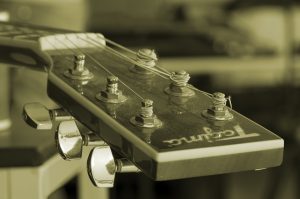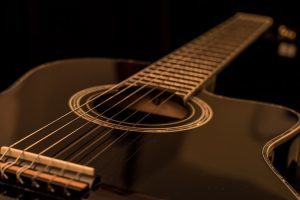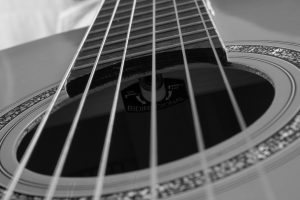The guitar has gone through many developments and there are always new things going on in terms of innovation. The acoustic guitar has been on the more “traditional” side of guitar types, with its distinguishing features being the wood from which it is made and its strings.
The electric guitar brought with it many new opportunities for amplifying the sound as well as modifying it, especially with things like the effect kit. On the other hand, the acoustic guitar seemed to remain in the “normal” sound of guitars.
In the past, if someone wanted to learn guitar, it was the acoustic guitar that was the “default” recommended guitar. Many things influenced this recommendation, one of them being the fact that the fret was wide and therefore would train the learner to stretch their fingers over a wider distance as compared to the electric guitar.

However, these days, there are people who prefer learning with the electric guitar.There is really no “right” or”wrong” way of learning, provided that the objective is met – to master the guitar.
Nevertheless, there are techniques that can only be enjoyed by the acoustic player and which add some gist to the guitar playing. Did you know that the structure of the acoustic guitar gives it percussion abilities? The following techniques help add a percussive effect to your guitar playing by going through the different parts of the drum set:
The Kick Drum Effect
The kick drum in the drum set, gives the bass and generally the basic beat of any song. With that in mind, you can hit the bottom strings of your acoustic guitar since they are the ones with the lower notes compared to all the other strings to add some spice to your guitar playing.

The kick sound that is most satisfying to me is found by striking the bottom three strings with my pick hand’s outstretched middle finger just in front of the bridge (see PHOTO A). If you’re using this technique in a live performance, make sure the sound technician understands what you’re going to do and provides a little more bottom end in the EQ to give your tone a satisfying thump.
As an added benefit, if you have a bass line going on the bottom strings, you can perfectly synchronize them with your kick pattern by attacking the notes with this same pick-hand finger. This guarantees that your virtual bassist and drummer will always be perfectly locked in together. Via Guitar World
The Snare Effect
The snare is responsible for giving a staccato sound and is usually used in orchestras and bands. The effect of the snare can be realized in the acoustic guitar in the following way:
There are several ways to achieve a snare drum–like effect on an acoustic guitar, and they all involve striking the instrument’s body anywhere that produces a pitch that is higher than that of the kick sound, which is pretty much anywhere.
My rule is that the snare is wherever I can reach it, based on whatever other duties either hand is performing. My go-to snare drum is at the top corner area of the body, which I likewise strike with my pick-hand middle finger. Via Guitar World

Hi-Hat Effects
The hi-hat is a set of cymbals which are played either when they are firmly together or when they are apart. It produces different sounds when the cymbals are together and when they are apart, best known as the open hi-hat or closed hi-hat. For you to achieve these sounds in your acoustic guitar playing, the following is what you should do:
By sweeping either hand along the wound strings, you can approximate the sound of closed or open hi-hats. Depending on your musical proclivities, you can conjure up a little old-school vinyl scratching by sweeping your hand over the strings in a way that visually resembles a DJ manipulating a record turntable (think Tom Morello). Via Guitar World
Are you now itching to try these effects out? Go ahead and spice up your guitar playing and give yourself a stunning new sound when playing.
Featured Image: Image Credit
I love how #SanFranciscoLive is acoustic & broken down, it’s beautiful how an acoustic guitar & harmonies can make the song so breathtaking?
— B✨ (@5sostheworld) September 19, 2016
The Acoustic Guitar Artistry of The Beatles’ #GeorgeHarrison https://t.co/7nvkIVMweP @thebeatles @GeorgeHarrison #TheBeatles pic.twitter.com/p0034sC6MD
— Guitar World (@GuitarWorld) September 21, 2016
Related Articles:
Check This Hybrid Acoustic Technique Showing One Very Cool Heavy Metal & Flamenco Lick…Nasty
In today’s video lesson is a break-down of a hybrid acoustic technique involving both heavy metal and flamenco…This really innovative approach shows what can be down when you look for ways to carve out a sound that is original and unique.
After watching this video lesson you will have a new found source of inspiration on maybe coming up with other ideas on how to fuse different styles in getting different tone out of your guitar. The acoustic makes for a amazing natural sound board of experimental ideas. Via Guitar Quicktips
Expand Your Guitar Playing with Phil Keaggy’s Capo Technique
Master Guitarist, Phil Keaggy, uses capos and looping to enhance his arrangements and performances. See how this guitar legend changes chord voicing by using two capos.
“Elixir Strings are my favorite strings in the world. I love how they feel, how they sound and how they maintain their clarity.”
– Phil KeaggyElixir Strings Phosphor Bronze with NANOWEB®Coating, Light/Medium Gauge
What makes Elixir Strings a favorite among artists like Phil Keaggy? It’s their great tone, smooth feel, no string squeak and extended tone life. And for Phil, it’s the Phosphor Bronze clarity and playability that enables his guitars to sound and feel their best in the studio and at shows. Via Acoustic Guitar
Exploring John Lennon’s Acoustic Guitar Technique with The Beatles
In the decades since his passing, on December 8, 1980, John Lennon’s legend has continued to grow, both for his contributions to the Beatles and his accomplishments as a solo artist.
Even so, he is rarely singled out for his acoustic guitar playing. This is perhaps due to the spotlight-grabbing abundance of “stand- alone” acoustic Beatles cuts written by Paul McCartney, such as “Blackbird,” “Yesterday,” “Michelle” and “Mother Nature’s Son.” But Lennon—wielding his Gibson J-160E or Martin D28—is the man behind many other Beatles acoustic classics, including “Norwegian Wood,” “Julia,” “Happiness Is a Warm Gun” and “Dear Prudence.” Via Guitar World

